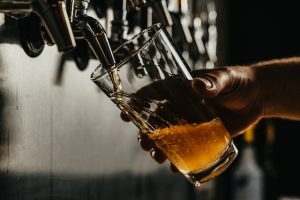Chapter 23: Alcohols, Ethers and Related Groups
Organic and Biochemistry Supplement to Enhanced Introductory College Chemistry
by Gregory Anderson; Jen Booth; Caryn Fahey; Adrienne Richards; Samantha Sullivan Sauer; and David Wegman
Chapter 23 Contents
- 23.1 Alcohols – Structure, Naming and Classification
- 23.2 Physical Properties of Alcohols
- 23.3 Formation of Alcohols
- 23.4 Reactions of Alcohols
- 23.5 Phenols
- 23.6 Ethers – Structure and Naming
- 23.7 Thiols
- Chapter 23 – Summary
- Chapter 23 – Review
- Chapter 23 – Infographic descriptions
Except where otherwise noted, this OER is licensed under CC BY-NC-SA 4.0
Please visit the web version of Organic and Biochemistry Supplement to Enhanced Introductory College Chemistry to access the complete book, interactive activities and ancillary resources.
In this chapter, you will learn about:
- Identifying alcohols, phenols, ethers and thiols
- Naming and drawing alcohols, phenols, ethers and thiols
- Reactions that produce alcohols
- Reactions of alcohols that produce other functional groups
To better support your learning, you should be familiar with the following concepts before starting this chapter:
- General concepts of organic chemistry and general reactions of carbon (from Chapter 19: Organic Chemistry)
- Hydrocarbon nomenclature and physical properties (Chapter 20: Alkanes and Alkyl Halides and Chapter 22: Alkenes, Alkynes, and Aromatics)
Previously, we considered several kinds of hydrocarbons. Now we examine some of the many organic compounds that contain functional groups. We first introduced the idea of the functional group, a specific structural arrangement of atoms or bonds that imparts a characteristic chemical reactivity to the molecule. If you understand the behaviour of a particular functional group, you will know a great deal about the general properties of that class of compounds. In this chapter, we take an in-depth look at alcohols, ethers and other related groups.

One of the more familiar alcohols on Earth is ethyl alcohol (ethanol). As the intoxicant in alcoholic beverages, ethanol is often simply called alcohol. If ethanol is diluted, as it is in wine, beer, or mixed drinks with about 1 oz of liquor, and if it is consumed in small quantities, it is relatively safe (Figure 23.0a.). In excess—four or more drinks in a few hours—it causes intoxication, which is characterized by a loss of coordination, nausea and vomiting, and memory blackouts.
Excessive ingestion of ethanol over a long period of time leads to cirrhosis of the liver, alteration of brain cell function, nerve damage, and strong physiological addiction. Alcoholism—an addiction to ethanol—is the most serious drug problem in the United States. Heavy drinking shortens a person’s life span by contributing to diseases of the liver, the cardiovascular system, and virtually every other organ of the body.
In small quantities—one or two drinks a day—ethanol might promote health. In addition to the possible benefits of modest amounts of ethanol, a chemical in red wines, resveratrol, is thought to lower the risk of heart disease. Resveratrol, found in red grapes, is an antioxidant. It inhibits the oxidation of cholesterol and subsequent clogging of the arteries. One need not drink wine to get the benefits of resveratrol, however. It can be obtained by eating the grapes or drinking red grape juice.
Watch More Organic Nomenclature: Heteroatom Functional Groups: Crash Course Organic Chemistry #3 (youtube.com) (12 mins).
Video Source: Crash Course. (2020, May 20). More Organic Nomenclature: Heteroatom Functional Groups: Crash Course Organic Chemistry #3 (youtube.com) [Video]. YouTube.
Attribution & References
Except where otherwise noted, this page is adapted by David Wegman and Samantha Sullivan Sauer from “14.0: Prelude to Organic Compounds of Oxygen” and “14.1: Organic Compounds with Functional Groups” in Basics of General, Organic, and Biological Chemistry (Ball et al.) by David W. Ball, John W. Hill, and Rhonda J. Scott via LibreTexts, licensed under CC BY-NC-SA 4.0. / A derivative of Introduction to Chemistry: GOB (v. 1.0), CC BY-NC 3.0.

